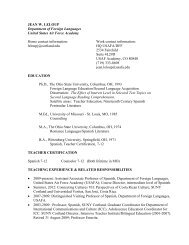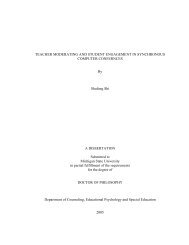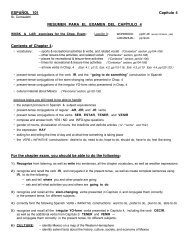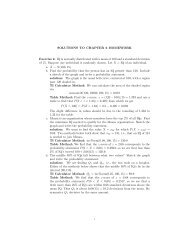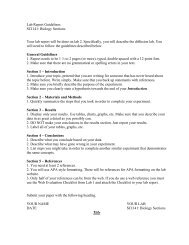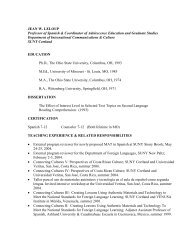EXS 387 - Biomechanics Lab #2b
EXS 387 - Biomechanics Lab #2b
EXS 387 - Biomechanics Lab #2b
Create successful ePaper yourself
Turn your PDF publications into a flip-book with our unique Google optimized e-Paper software.
<strong>Lab</strong> time: ___________________________<br />
Name: _____________________________<br />
<strong>EXS</strong> <strong>387</strong> - <strong>Biomechanics</strong><br />
<strong>Lab</strong> <strong>#2b</strong> - ANATOMICAL ANALYSIS OF MOVEMENT<br />
Learning objective: Identify the muscles active during each phase of a human movement.<br />
Analysis procedures:<br />
1. Identify the joint action.<br />
2. Identify the type of muscle contraction (concentric, eccentric, or isometric).<br />
a. Determine if the mechanical energy of the limbs and body increase (speeding up or lifting), decrease<br />
(slowing down or lowering), or don't change (no movement at joint).<br />
b. The change in energy indicates the total work done (positive, negative, or zero).<br />
c. If no external forces other than gravity act on the limbs and body, then the muscle action is:<br />
• concentric if positive work is done<br />
• eccentric if negative work is done<br />
• isometric or no action at all if zero work is done.<br />
d. If external forces other than gravity do act on the limbs and body, then imagine what would happen at<br />
the joint if no muscle contractions occurred:<br />
• if the imagined joint action is the same as the joint action observed but faster, then the muscle<br />
action is eccentric.<br />
• if the imagined joint action is opposite to the joint action observed, then the muscle action is<br />
concentric.<br />
• if no joint action was observed, but there is imagined joint action, then the muscle action is<br />
isometric and the active muscle group is an antagonist to the imagined joint action.<br />
3. Identify the role of the active muscle group.<br />
a. If the muscle action is concentric - the active muscles are agonists to the joint action.<br />
b. If the muscle action is eccentric - the active muscles are antagonists to the joint action.<br />
c. If the muscle action is isometric - the active muscles are stabilizers.<br />
4. Identify the active muscle group.<br />
a. If the active muscles are agonists to the joint action - the muscles produce a torque in the same<br />
direction as the joint action, e.g., if the joint action is flexion and the active muscles are agonists, then<br />
the active muscle group is the flexor group (the active muscles are flexors).<br />
b. If the active muscles are antagonists to the joint action - the muscles produce a torque in the opposite<br />
direction of the joint action, e.g., if the joint action is flexion and the active muscles are antagonists,<br />
then the active muscle group is the extensor group (the active muscles are extensors).<br />
c. If the active muscles are stabilizers, then the active muscle group must be determined by an analysis<br />
of what other torques act around the joint.<br />
5. Identify the specific muscles in the muscle group. Use your knowledge of functional anatomy or look in<br />
your anatomy textbook.<br />
In lab activities:<br />
Together, the class will analyze the following activities. For each phase of each activity and for each joint,<br />
identify the joint action occurring, the type of muscular contraction, the role of the active muscles, and the<br />
active muscle group. A sample analysis of a bench press is shown.<br />
1. BENCH PRESS Phases: up and down Joints: elbow and shoulder<br />
2. PUSH UP Phases: down and up Joints: elbow and shoulder<br />
3. SIT UP Phases: up and down Joints: hip and intervertebral
5-6<br />
Name ____________________________________________ page 2<br />
EXAMPLE ANALYSIS OF BENCH PRESS (wide grip)<br />
Phase of<br />
Joint<br />
Muscle<br />
Joint<br />
Motion<br />
Action<br />
Contraction<br />
(not position)<br />
Role of<br />
Active<br />
Muscles<br />
Active<br />
Muscle<br />
Group<br />
ELBOW DOWN flexion eccentric antagonist extensors*<br />
SHOULDER<br />
UP extension concentric agonist extensors<br />
DOWN<br />
horizontal<br />
eccentric antagonist<br />
horizontal<br />
abduction<br />
adductors**<br />
horizontal<br />
horizontal<br />
UP<br />
concentric agonist<br />
adduction<br />
adductors<br />
*Active elbow muscle group and muscles: extensors: triceps, anconeus<br />
**Active shoulder muscle group and muscles: horizontal adductors - pectoralis major, anterior deltoid,<br />
coracobrachialis<br />
1. SPRINTING: Analyze the sprinter (Coby Miller) shown in the sequence photos included with in <strong>Lab</strong> #2 by<br />
completing the charts on pages 4 and 5. The analysis will encompass one full stride from Frame 1 through<br />
Frame 8. Seven phases will be analyzed, each phase representing the movement occurring from one frame to<br />
the next. Analyze the movements at the right hip, right knee, right ankle, right shoulder, and right elbow<br />
joints.<br />
The charts you complete on pages 2 through 4 are your write up for this lab. You are allowed (and encouraged)<br />
to use a pencil when completing the charts for this lab write up.<br />
SPRINTING<br />
Joint<br />
Frames<br />
Joint<br />
Action<br />
(not position)<br />
Muscle<br />
Contraction<br />
Role of<br />
Active<br />
Muscles<br />
Active<br />
Muscle<br />
Group<br />
RIGHT 1-2<br />
HIP 2-3<br />
3-4<br />
4-5<br />
5-6<br />
6-7<br />
7-8<br />
RIGHT 1-2<br />
KNEE 2-3<br />
3-4<br />
4-5
Name ____________________________________________ page 3<br />
6-7<br />
7-8<br />
RIGHT 1-2<br />
ANKLE 2-3<br />
3-4<br />
4-5<br />
5-6<br />
6-7<br />
7-8<br />
Identify each active hip muscle group and list the specific muscles within each group:<br />
SPRINTING (continued)<br />
Joint Frames<br />
Joint<br />
Action<br />
(not position)<br />
Muscle<br />
Contraction<br />
Role of<br />
Active<br />
Muscles<br />
Active<br />
Muscle<br />
Group<br />
RIGHT 1-2<br />
SHOULDER 2-3<br />
3-4<br />
4-5<br />
5-6<br />
6-7<br />
7-8<br />
RIGHT 1-2<br />
ELBOW 2-3<br />
3-4<br />
4-5<br />
5-6<br />
6-7<br />
7-8
Name ____________________________________________ page 4<br />
Identify each active ankle muscle group and list the specific muscles within each group:<br />
Identify each active shoulder muscle group and list the specific muscles within each group:<br />
Identify each active elbow muscle group and list the specific muscles within each group:
Name ____________________________________________<br />
page<br />
Summary of the analysis procedures:<br />
Identify joint action.<br />
Is the work done positive or negative?<br />
There is no joint action.<br />
Positive work Negative work Zero work<br />
What would happen if the muscles<br />
were relaxed (not contracting).<br />
Concentric contraction<br />
Eccentric contraction<br />
No joint<br />
action<br />
occurs<br />
Joint action<br />
occurs<br />
Agonist<br />
Antagonist<br />
Isometric<br />
contraction<br />
Stabilizer<br />
Active muscle group<br />
exerts torque in same<br />
direction as joint<br />
action, i.e., if joint<br />
action is flexion then<br />
active muscle group is<br />
flexors<br />
Active muscle group<br />
exerts torque in<br />
opposite direction as<br />
joint action i.e., if<br />
joint action is flexion<br />
then active muscle<br />
group is extensors<br />
No muscle<br />
activity<br />
Active muscle group exerts torque in<br />
opposite direction as imagined joint action<br />
i.e., if imagined joint action is flexion then<br />
active muscle group is extensors



